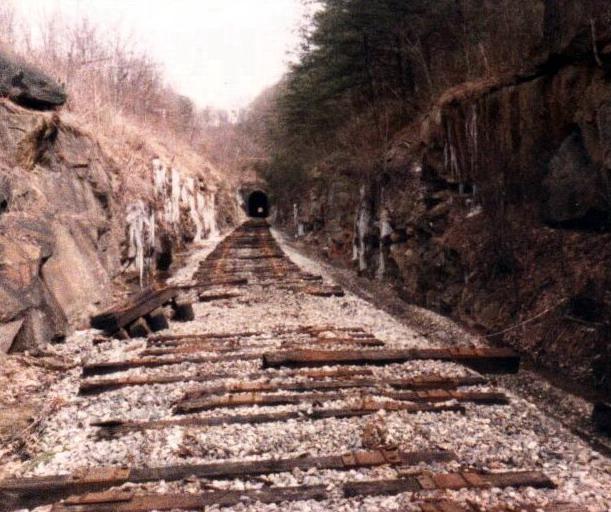Hogshead Hollow Road, Denton, Ky
July 2, 2008 This morning I went out to the Denton area to find the Williams Creek (aka Means) Tunnel. In this part of Carter County, the old C&O right-of-way leaves Denton proper and heads east, then north-northeast toward Rush. Immediately east of Denton the ROW roughly parallels Glancy Fork Road and but then turns and runs just to the west of Hogshead Hollow Road. The first two photos were taken about a mile up Hogshead Hollow, west on Cemetery Road where it crosses the ROW. The third photo is near the end of Hogshead Hollow. The ROW has just crossed Hogshead Hollow Road and is proceeding in a northeasterly direction toward the tunnel. This area of the ROW is very wet and muddy and overgrown with low, marshy plants. Ten to fifteen foot high rock cuts closely constrict the ROW through the short passage to the tunnel entrance. Photo six shows an interesting 20 foot high rock face just to the north (left) of the ROW immediately in front of the tunnel. Photo seven shows the first sight of the tunnel entrance. As with the Aden Tunnel, both entrances to the tunnel are blocked. I was surprised to find that the Williams Creek Tunnel appears to be completely timber framed (rather than re-enforced concrete as is the case with the Aden Tunnel). The speck of light at the tip of the leaf is light entering the opposite end of the tunnel. Actually the other end of the tunnel is not that far away. I was told that the tunnel was 4,000 feet long, but I seriously doubt that. By my very rough estimate, I would guess that the tunnel is less than 1,500 feet long. While the Aden tunnel is bone dry inside, the Williams Creek Tunnel is essentially a pond. The photos that I took of the inside did not come out, but from the west entrance it appeared that there is two to four feet of water on the floor of the tunnel. This would indicate to me that future use of the tunnel for the rails-to-trails project is going to be highly problematic. Removing the water from the tunnel would be a simple matter, but we would have to be concerned that the combination of standing water and timber framing may have already compromised the integrity of the tunnel support structure. The last photo shows a thermometer that someone has left in the tunnel. This tunnel appears to be quite a bit narrower than the Aden Tunnel.

The Williams Creek Tunnel after the tracks were pulled up and before the tunnel was blocked
Note the rectangular plates with the four holes in them laying on the ties.
The rails rested on these "tie plates" and steel spikes (or later, bolts) were driven through the four holes,
securing the rails to the cross ties ("sleepers"). One edge of the spike head (or bolted anchor) overlapped the flange
on the foot of the steel rail. These plates assisted in more securely attaching the rails to the sleepers,
and they more evenly distributed the load and forces over the the surface of the sleepers, greatly lengthening the life of the ties.
Submitted by: John W. Grace